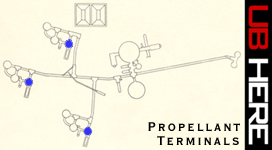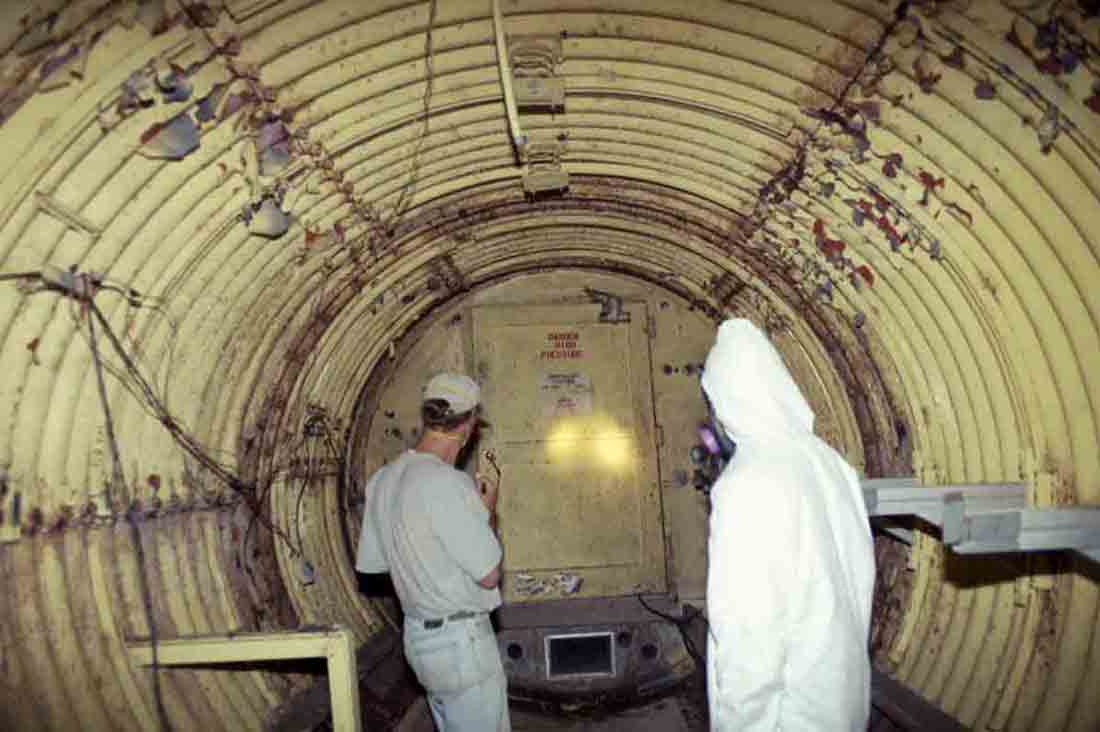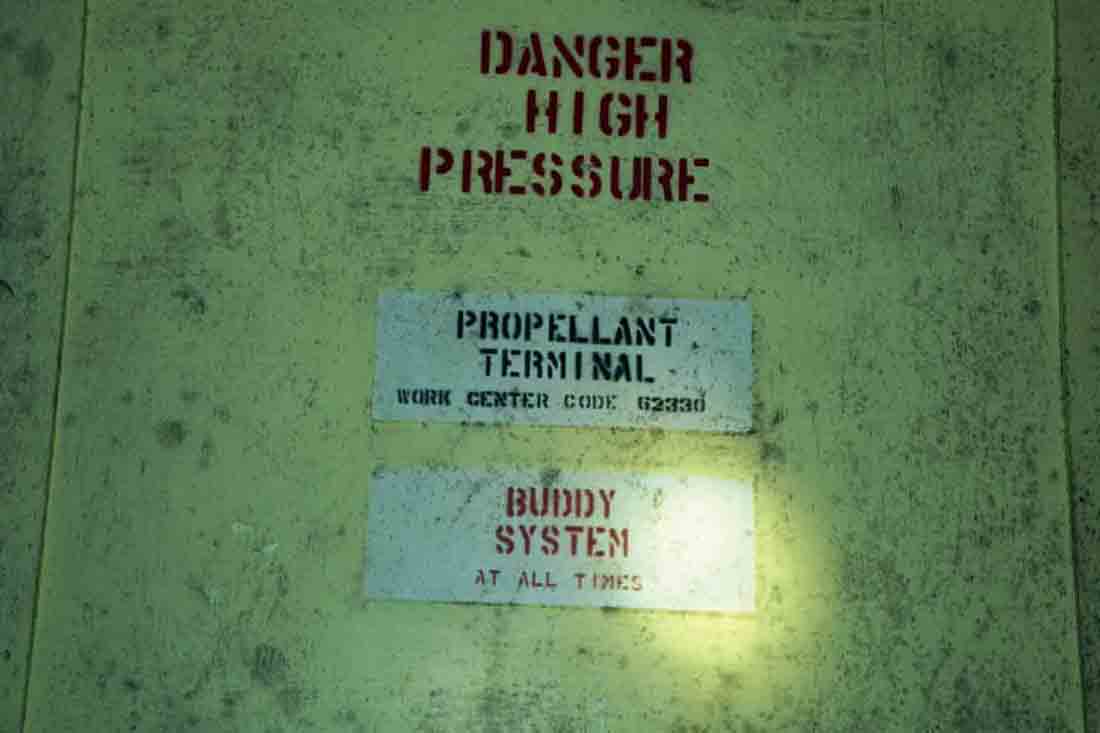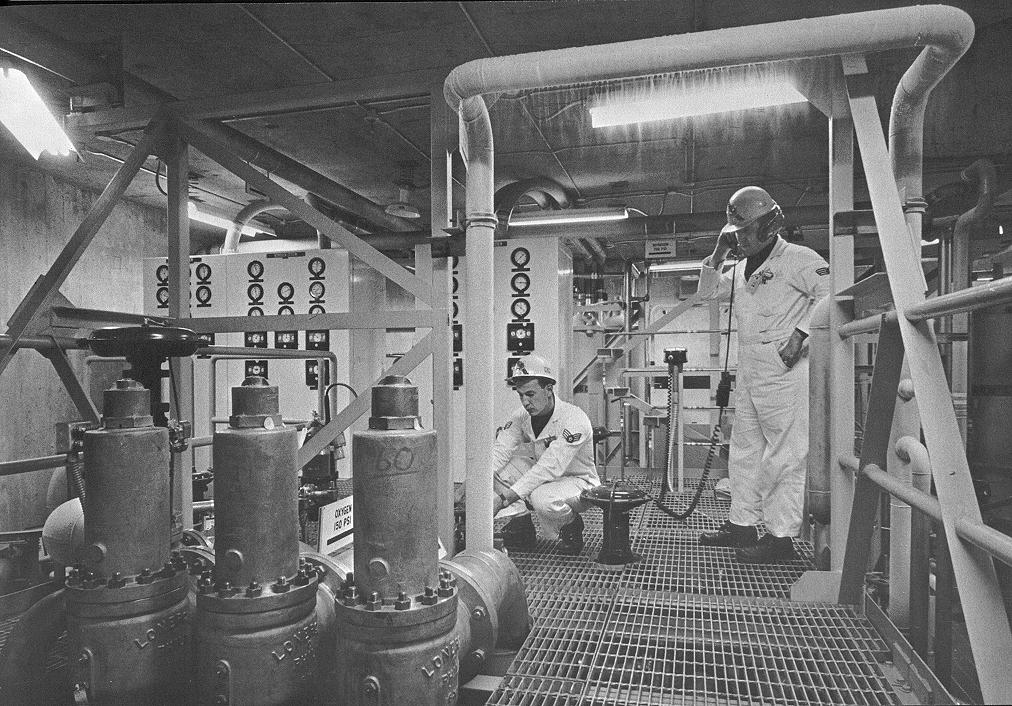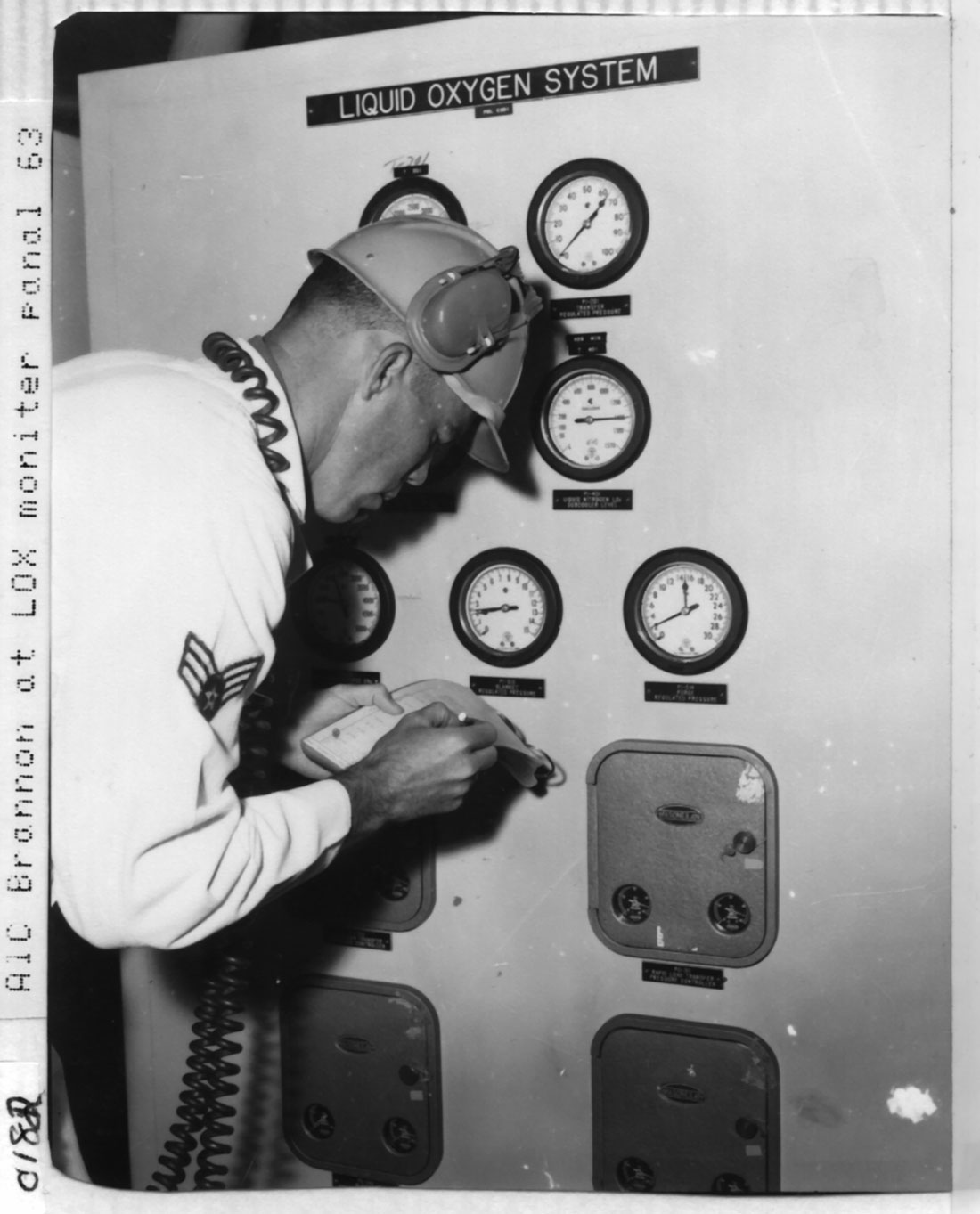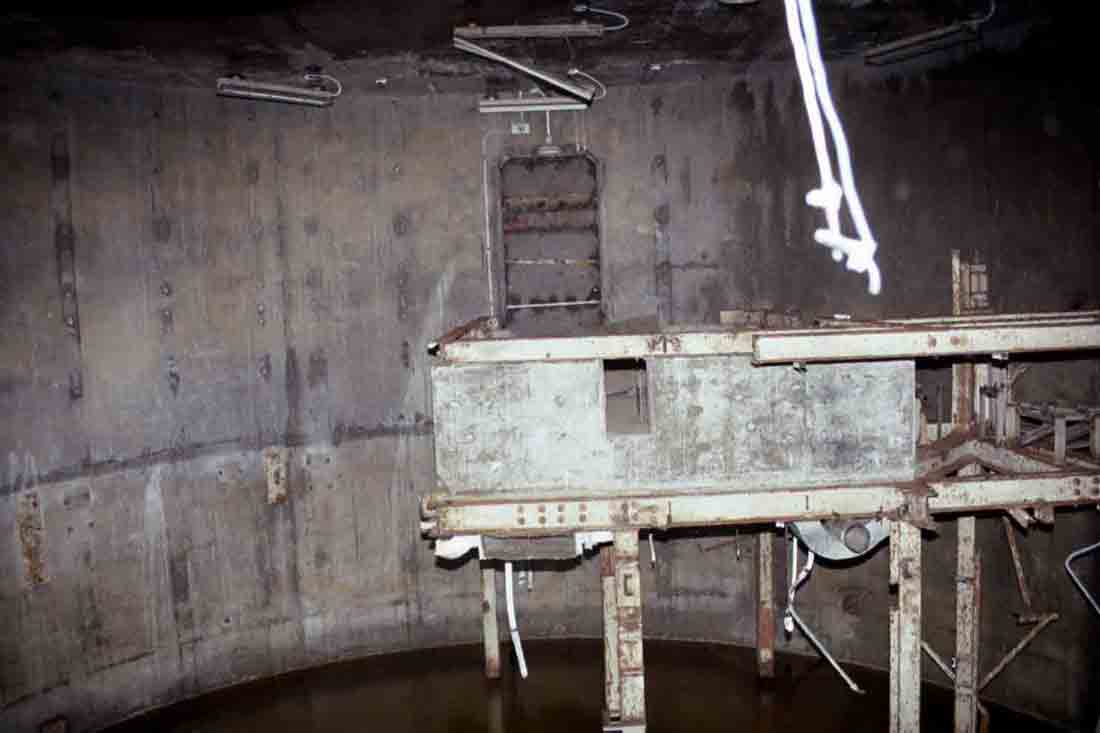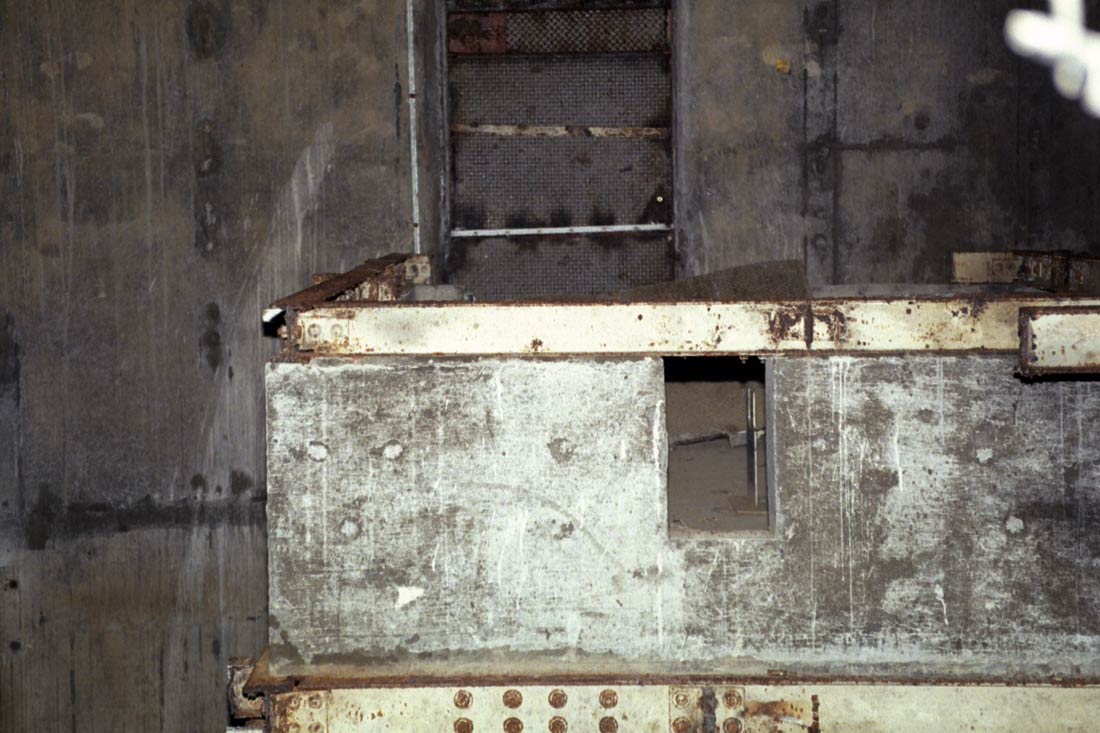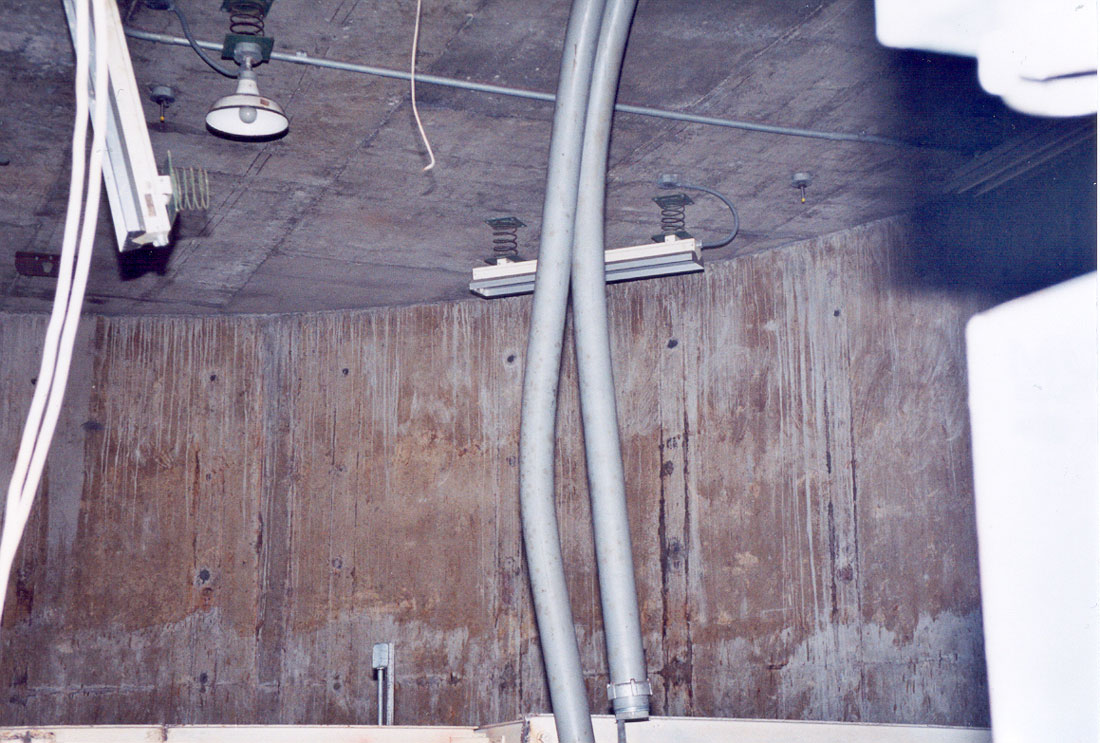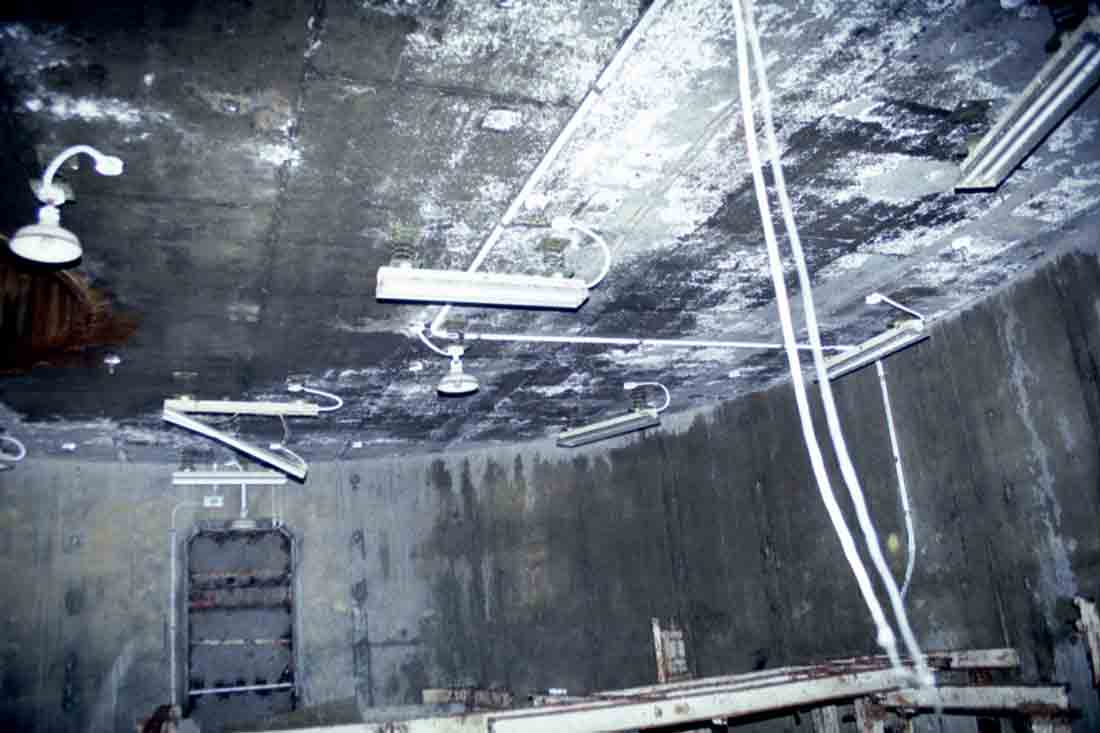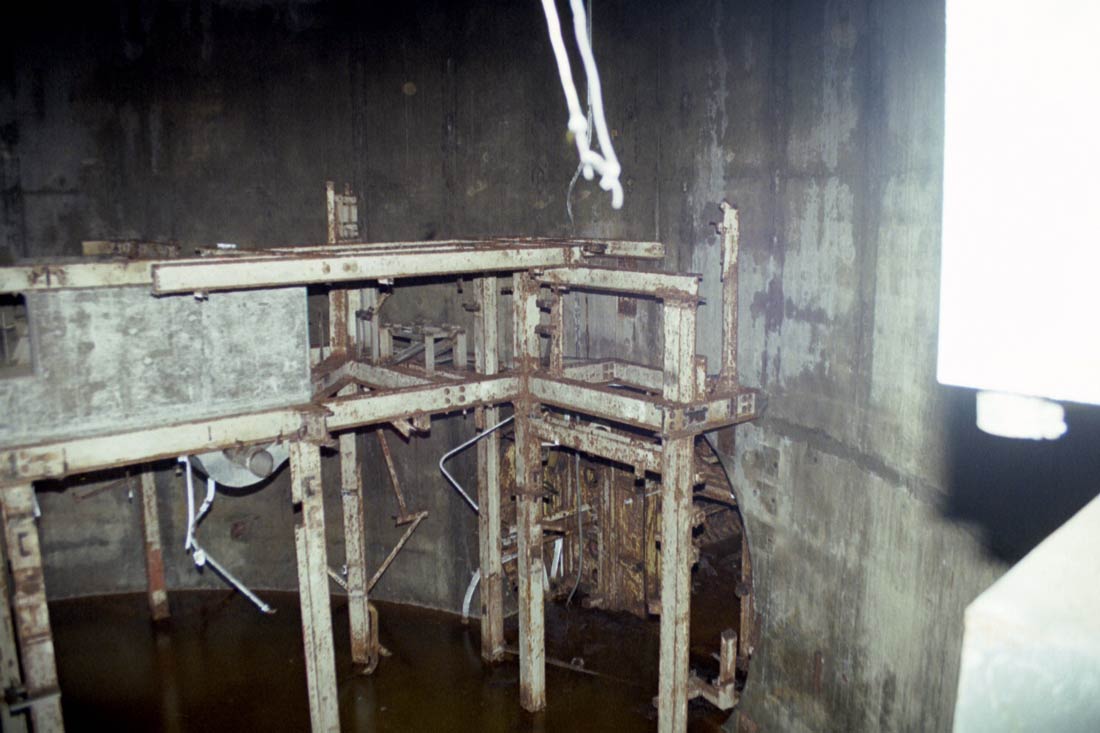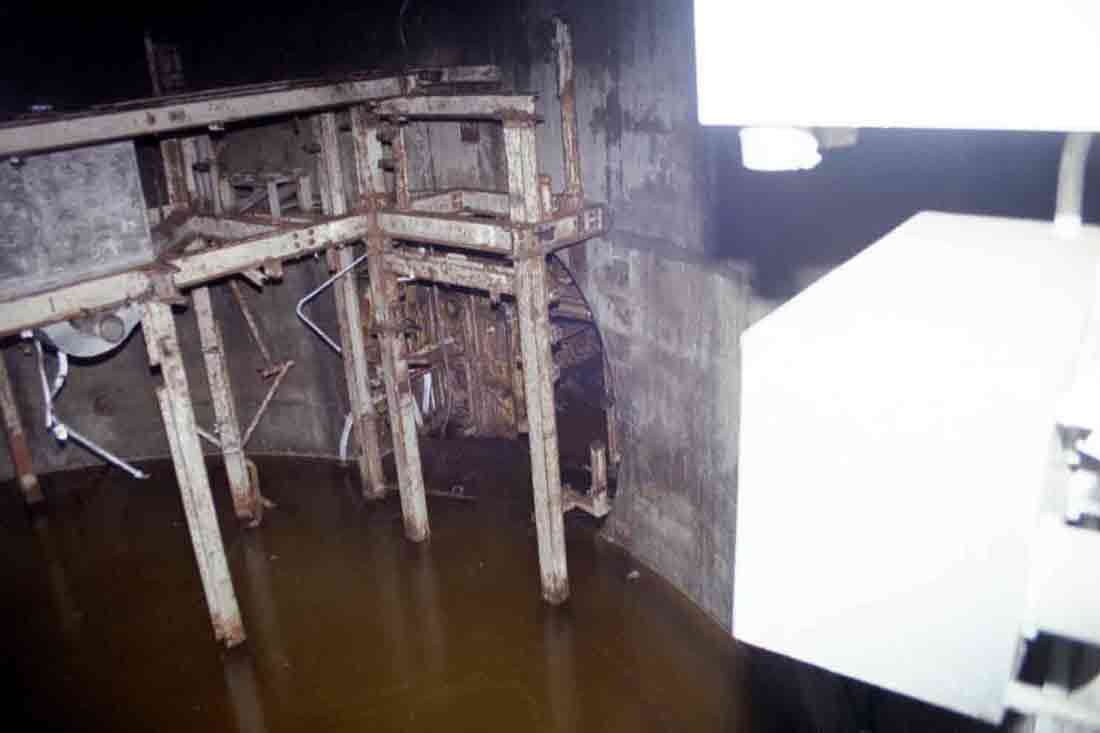|
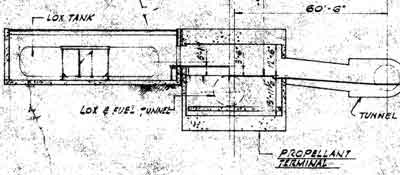
Propellant
Terminal - Side aspect
|
|
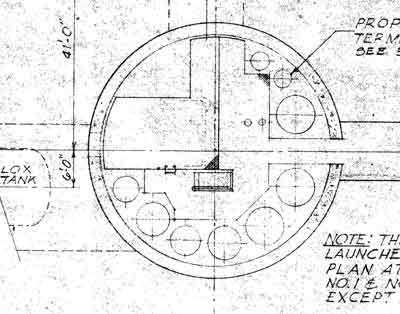
Propellant
Terminal - Top-down view
|
The
propellant terminal is another cylindrical structure, 37'6" in
diameter, 2 stories high with reinforced concrete walls 18" thick
used to store liquid oxygen (LOX), liquid and gaseous nitrogen and
helium as well as equipment for controlling the transfer of these
gasses from their storage tanks to the missile and to support
equipment.
The
upper level contained the LOX, nitrogen and helium transfer panels, and
the lower level contained a helium cooler and LOX sub cooler and
various vacuum pumps for the coolers. The whole terminal was filled
with non-reactive stainless steel plumbing for transfer of the volatile
liquids and gasses along with standard steel and
other piping for compressed air and water.
|
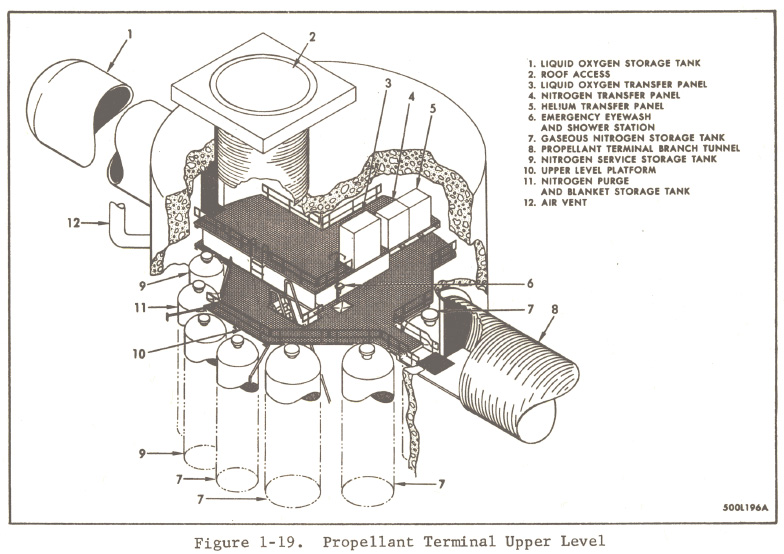
Upper
level - Each of the upright tanks in the illustrations are actually an
array of 4, 6 or 7 gas cylinders
|
|
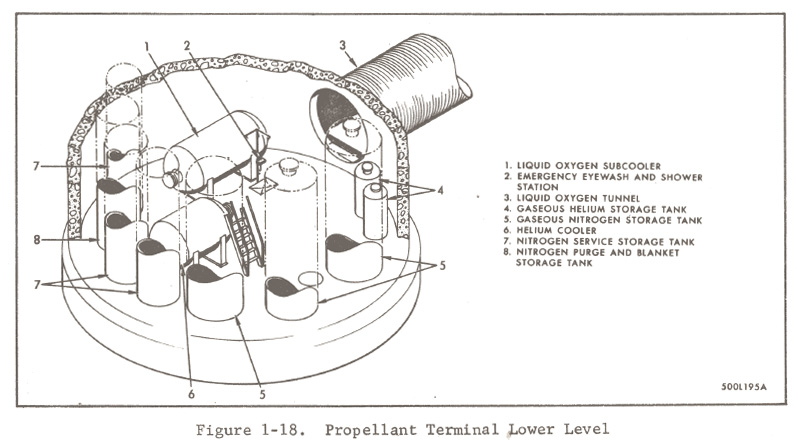
Lower
level - The LOX sub-cooler and other storage tanks and piping occupied
the lower level
|
The
propellant terminal is connected to the missile silo by the LOX tunnel
on the lower level and to the LOX bay containing the LOX storage tank
on the upper level. The LOX
tunnel in turn is connected to the LOX loading and vent shaft that
runs to the surface.
The
LOX tunnel routed the LOX lines from the propellant terminal to the
missile and its oxidizer tanks and also carried helium and nitrogen to
the silo and the missile.
The
LOX bay contained the double-walled stainless steel LOX tank suspended
in a giant steel cradle designed to attenuate the transfer of ground
shocks to the pressurized vessel containing the thousands of gallons
(each tank had a capacity of 28,000 gallons) of oxidizer for that
particular launcher silo.
|
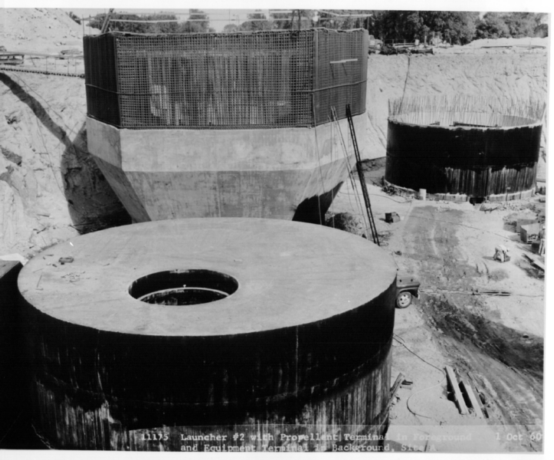
One
of the launcher areas under construction prior to backfilling.
The propellant terminal in the foreground with the launcher silo in back
and the equipment terminal in the upper right.
Note
the thickness of the concrete roof visible at the circular access
portal.
|
|
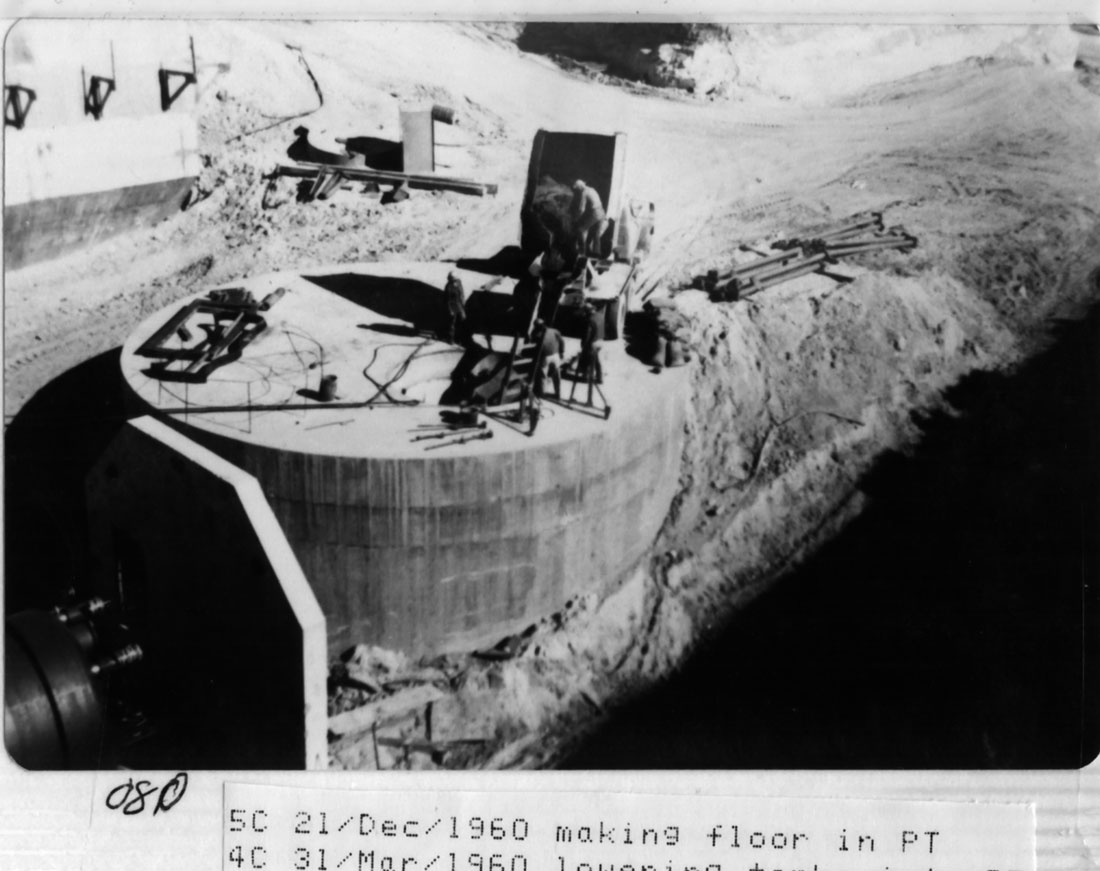
View
of the propellant terminal with the LOX bay visible on the left.
The LOX tank and connections can also be seen here. At this stage
the interconnecting tunnels to the launcher area have yet to be
installed.
Photo
courtesy of Fred Epler
|
|

Spring
suspension mounts to support the propellant terminal floors.
Everything had to be able to withstand shock or a disastrous failure could
occur. The entire two-story structure was "floated" on
these springs.
Photo
courtesy of Fred Epler
|
It
was paramount that the propellant systems not be damaged both to
ensure launch capability and to avoid catastrophic fires and
explosions that could render the entire complex unusable.
There
was no greater threat to alert status and crew life and limb than the
propellants that drove the rocket motors. Even the warheads were a
far lesser hazard-- they were so sufficiently safeguarded that an
accidental detonation was unlikely even if the missile itself
exploded.
Fun
Facts About Modern Rocket Propellants
I
find it interesting that the
Titan II, which replaced the Titan I and all the existing Atlas
configurations at the time, was actually far more hazardous in terms
of the propellants used. Aerozine 50 and (50% unsymmetrical
dimethylhydrazine and 50% hydrazine) and nitrogen tetroxide are
hypergolic propellants, which means that they spontaneously
ignite when mixed. This is great inside of a rocket motor-- not
so great pretty much everywhere else.
Both
nitrogen tetroxide and the components of Aerozine 50 are highly
bio-hazardous and toxic:
Unsymmetrical
dimethylhydrazine (UDMH, C2H8N2):
-
Highly
flammable and highly explosive
-
Highly
corrosive
-
Forms
other toxic compounds when burned
-
Evaporates
easily at room temperature
-
Easily
absorbed through skin, eyes and lungs
-
Attacks
the central nervous system, liver and lungs
-
Causes
respiratory failure, liver impairment and death
-
Carcinogenic
-
Hazardous
to the environment
Hydrazine
(N2H4):
-
Highly
explosive and flammable
-
Reactive
with moisture
-
Forms
other toxic compounds when it breaks down
-
Can
be fatal with severe exposure
-
Highly
irritating if inhaled
-
Can
be absorbed through skin
-
Corrosive
to skin
-
Carcinogenic
-
Attacks
the blood, kidneys, lungs, mucus membranes and central nervous
system
-
Damages
organs with repeated exposure
Dinitrogen
Tetroxide (N2O4):
-
May
spontaneously ignite combustible materials
-
Reacts
with water to form corrosive acids
-
Reacts
with metals in the presence of water to form highly flammable
hydrogen gas
-
Highly
toxic if inhaled
-
Corrosive
to skin, eyes and respiratory tract
-
Can
cause fatal pulmonary edema
-
Accelerates
combustion
-
Hazardous
to the environment
These
propellants are still in use in one form or another today in both
domestic and foreign liquid-fueled rocket engines despite the
challenges presented by their use, storage and transport. The
most likely reason for this is the elimination of an ignition system
given their hypergolic property-- removing one more point of failure
in an extremely complex and expensive system.
|
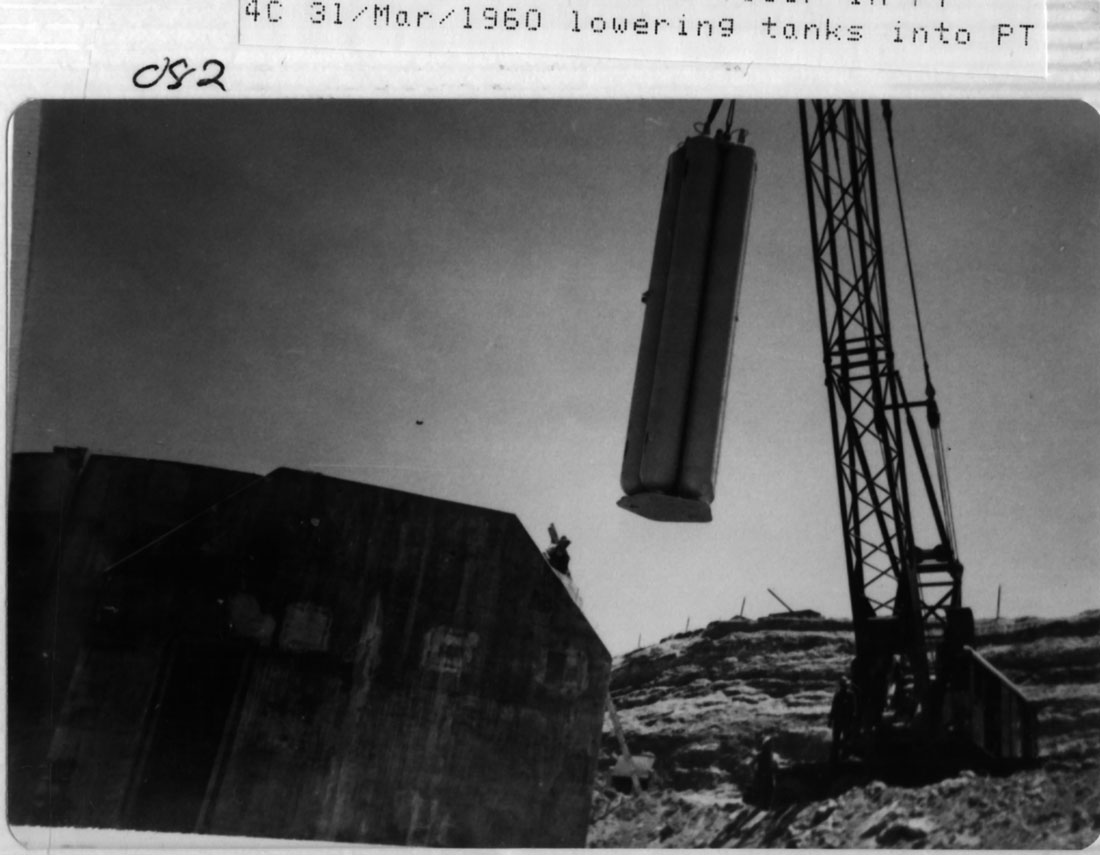
Installation
of the gas cylinders into the propellant terminals through the roof
access Photo
courtesy of Fred Epler
|
|
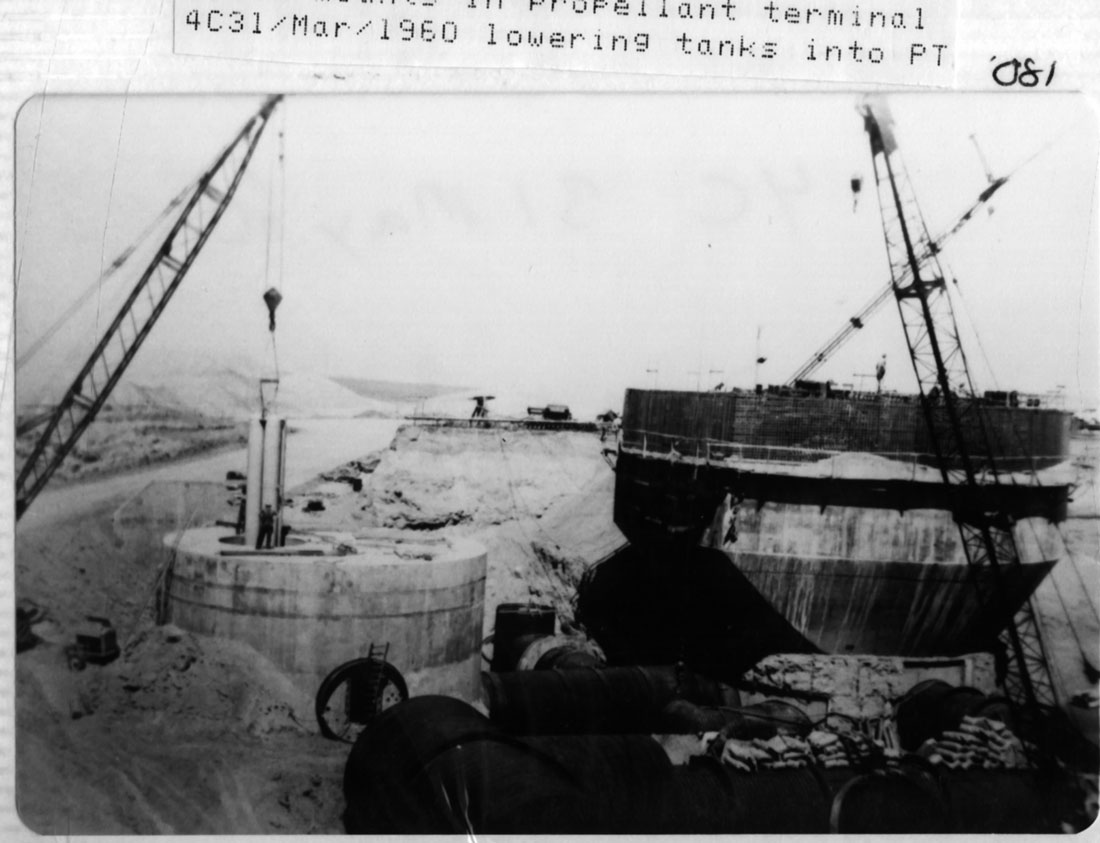
One
cluster at a time, each set of tanks was carefully emplaced Photo
courtesy of Fred Epler
|
|
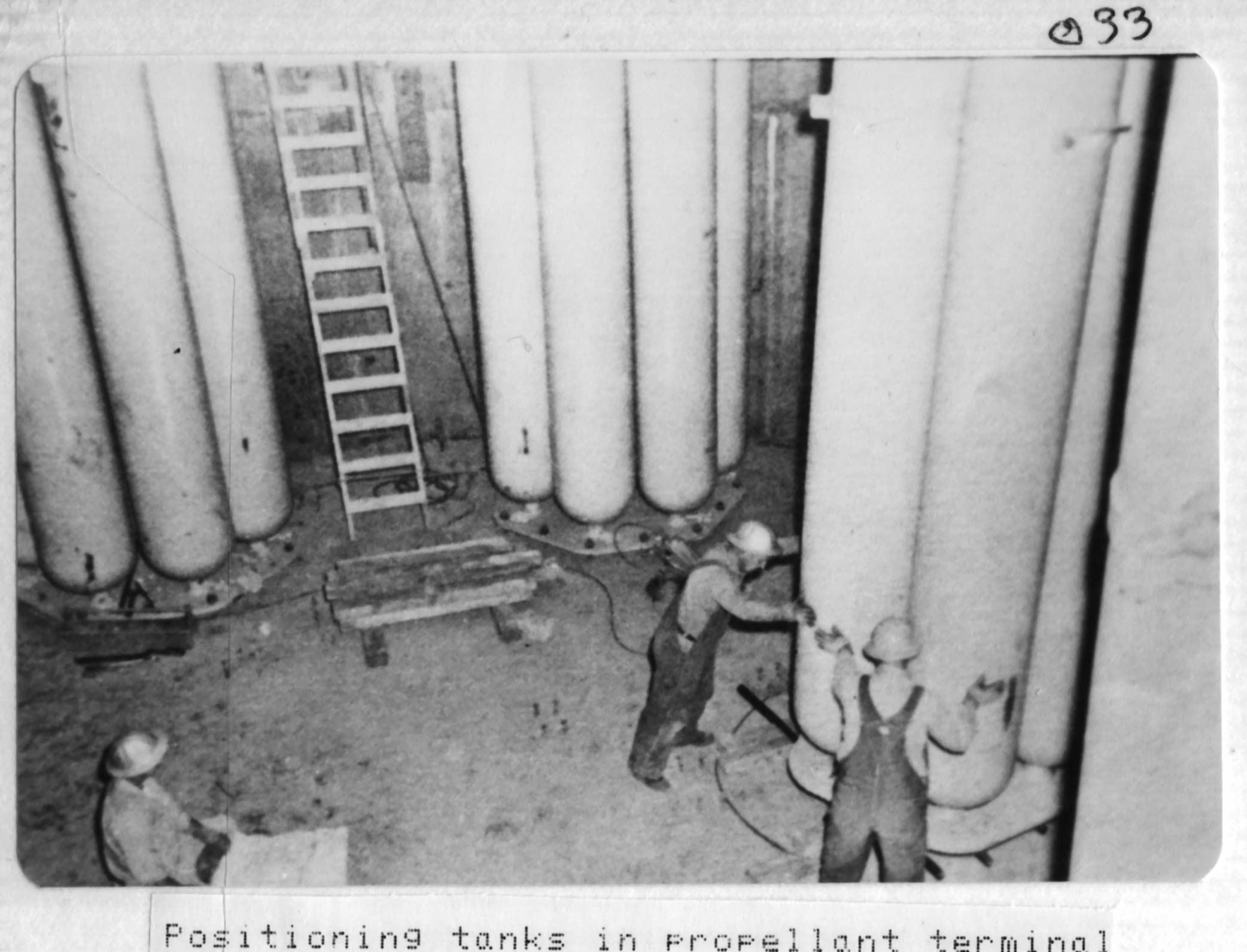
Groups
of tanks being positioned and bolted in place Photo
courtesy of Fred Epler
|
Cryogenic
Gasses and You
Liquid
oxygen and liquid nitrogen are "cryogenic gasses", which are
gasses which have been chilled to the point where they change to a
liquid state. For liquid oxygen, O2
is chilled and maintained at around -170 degrees Celsius or -274
F. It probably does not need to be said (but here I go anyway)
that anything which is -100 Celsius or colder is likely to be quite dangerous.
As
it was with the rest of the Titan I complex, all the piping in this
area was
allowed a certain degree of movement through the use of flexible
connections and gimbaled joints to help prevent ruptures to the very
complicated plumbing in this area. Because LOX is a concentrated
oxidizer, the piping and fittings were all stainless steel or other
non-reactive metals and were cleaned to stringent standards. Any
particulate, especially oil or grease in a LOX line can produce an
explosion.
|
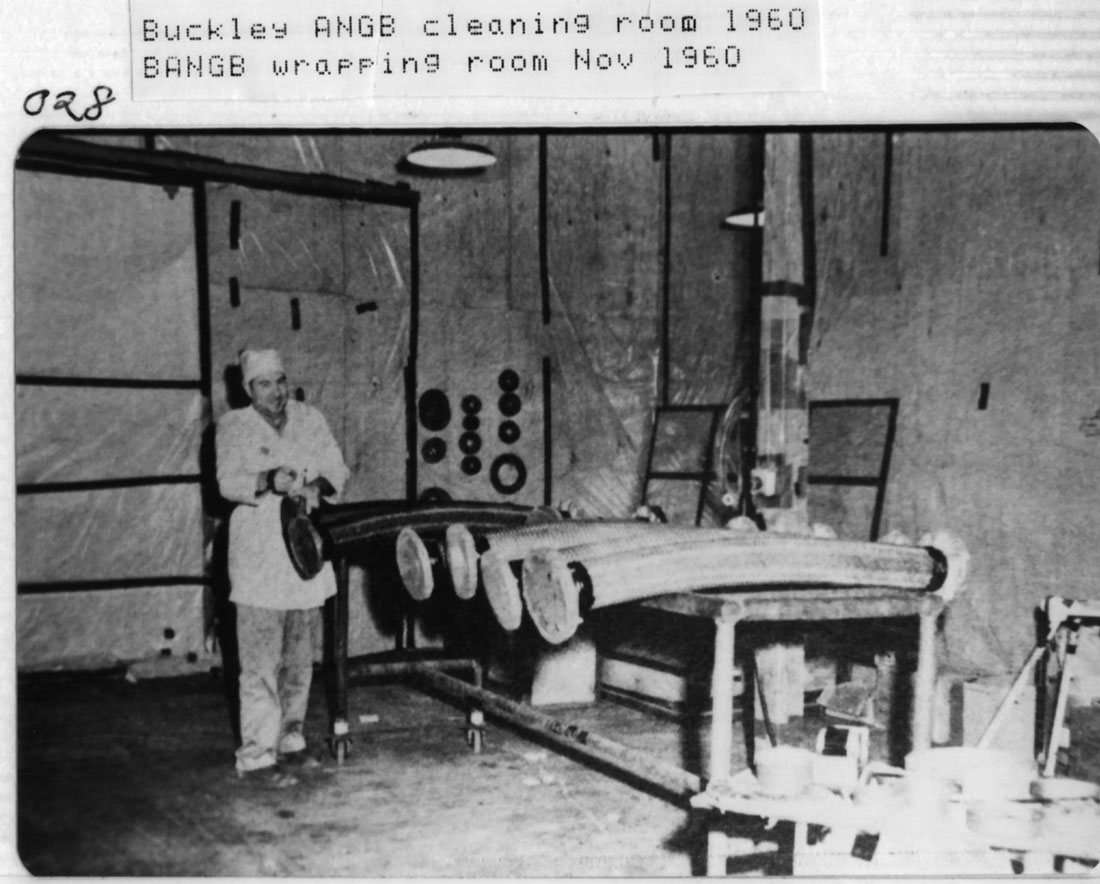
A
makeshift
clean room at the nearby Buckley Air National Guard base for
cleaning and drying components of the Propellant Loading System.
All conduit, valves and connectors had to be meticulously cleaned and
dried using nitrogen gas and then wrapped to keep out contaminants prior
to shipment and installation on site.
Photo
courtesy of Fred Epler
|
|
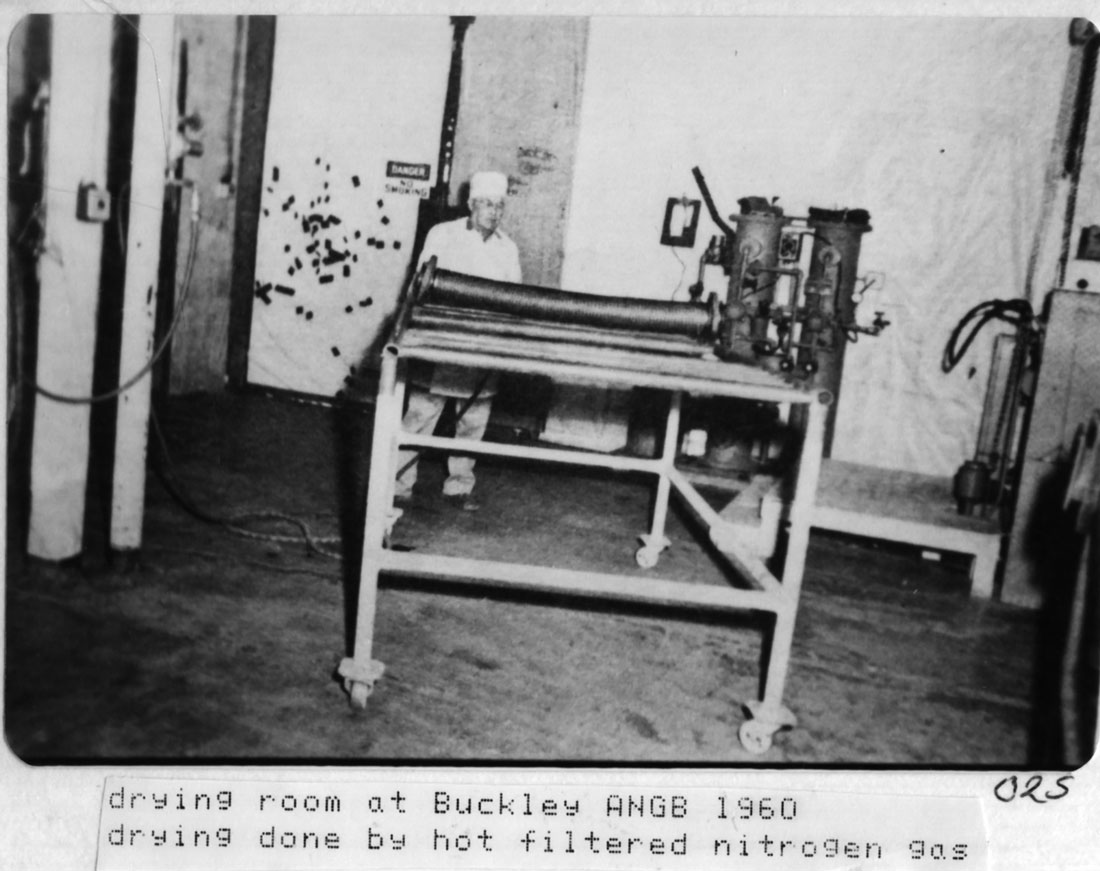
Drying
room with twin-column dryer at right rear. I regret I do not know
the names of the men in these pictures (and many others throughout this
website) so I cannot credit them for their
contribution to these early days of US missile defense. If anyone
knows who they are, please contact me.
Photo
courtesy of Fred Epler
|
Smoking
was an obvious no-no in the propellant terminal, but the liquid oxygen
presented other hazards beyond violent oxidation, presenting a
veritable cornucopia of potential dangers. Chief among these
dangers is the presence of oil or grease-- or any hydrocarbon that
could spontaneously create a fire or explosion. Hands, clothing,
tools and anything else entering the propellant terminal had to be
clean, static resistant and not emit any possible sources of ignition.
Sparks
and open flame are of course not safe near LOX and dropping tools is
also discouraged as it may produce a spark or if dropped on spilled
LOX could also result in an explosion. Special bronze tools are
commonly employed in such environments for the simple reason that they
will not produce a spark when dropped or striking another surface.
Appropriate
gloves, boots and aprons (to protect against spillage) were part of
the necessary gear for handling LOX. Aprons were mostly for fill
and drain operations, but leaks were always a concern. Because
of the enormous difference in temperature of piping and connectors and
the ambient temperatures when cryogenic liquids are channeled through them,
seals, bolts and connections expand or contract unevenly, pretty much
guaranteeing leaks during a transfer. For this very reason, a
catch basin was located below the steel floor grating to collect
spillage. An emergency eyewash
station and shower was provided on both levels of the propellant
terminals in case of accidental contact.
|
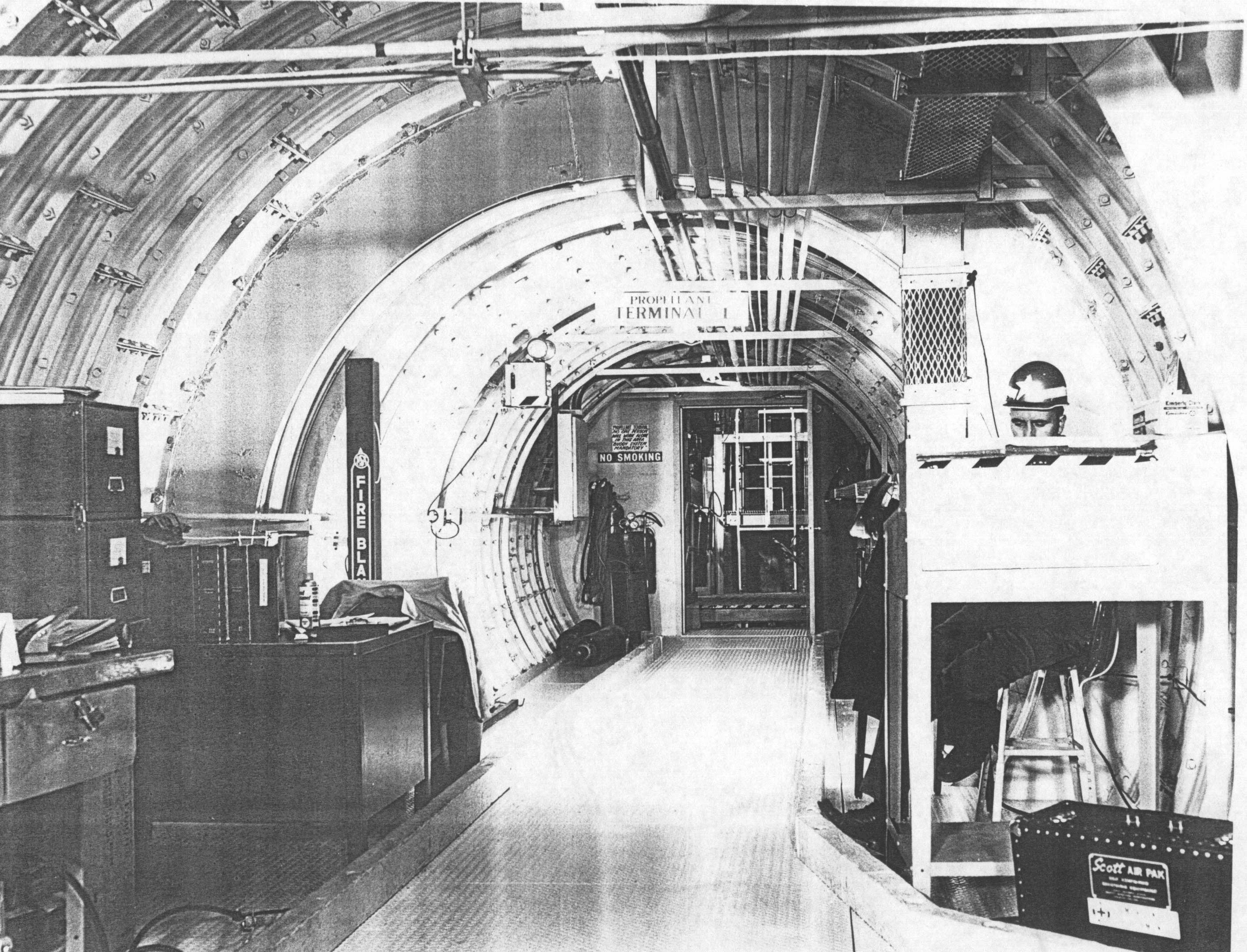
Operational
photo of the entrance to one of the three propellant terminals
|
I
wish I had gotten more photos of this area, and even more so I wish I
had climbed up the remaining structure for some better shots. The
water you see here is over 2 feet deep and I guess I didn't feel like
dropping my camera in it when I passed through here.
The
entrance to the LOX tunnel is at the upper right in the above
photo. I did finally venture there to get some pictures which you
can see in the LOX tunnel section of the site (once it is complete,
sorry it is not up yet).
|
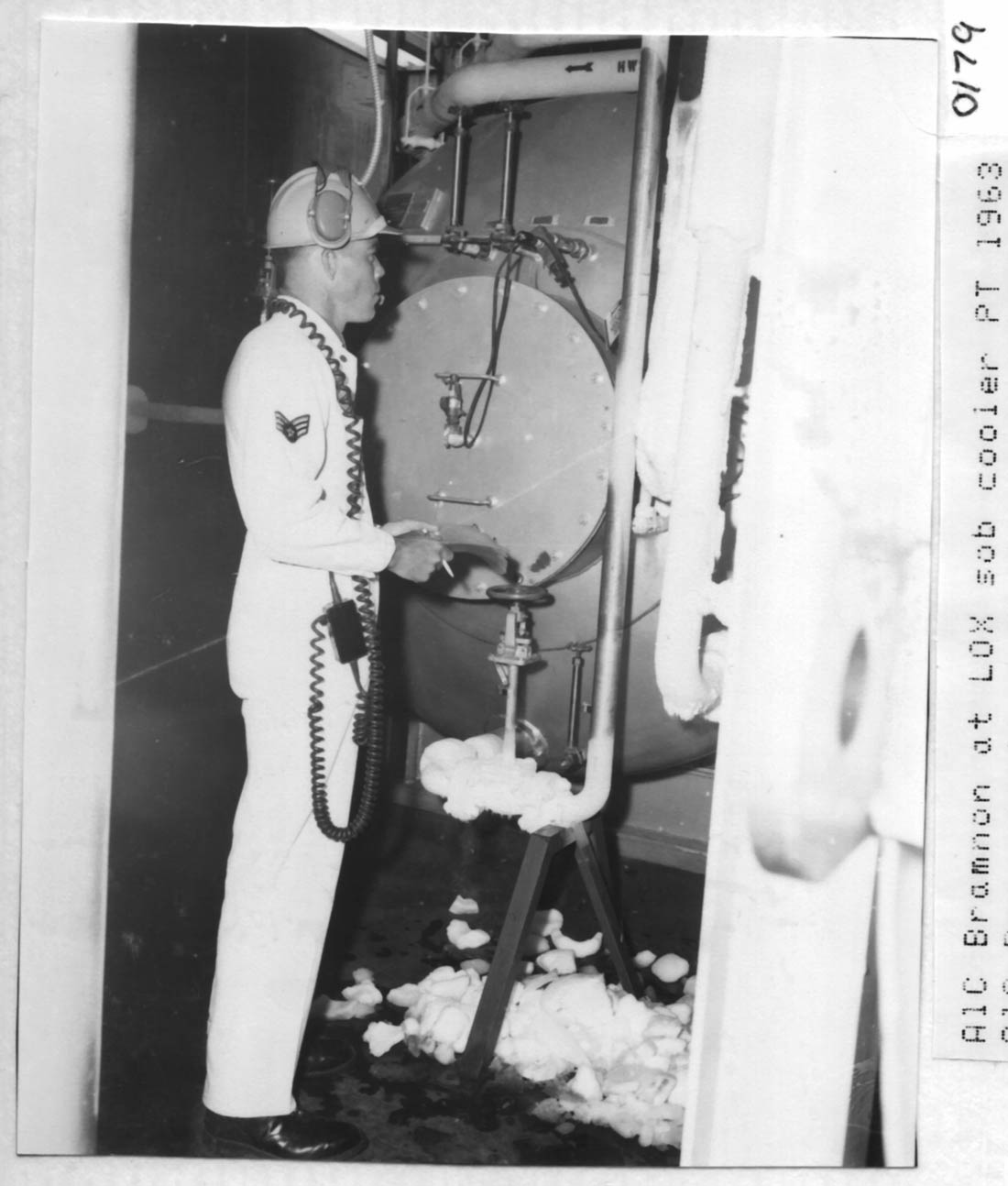
A1C
Brannon continuing his maintenance checklist on the lower level.
This is the LOX sub-cooler he's standing near-- it helped maintain the
-274F temperature needed to keep the liquid oxygen from becoming gaseous
again.
Note
the accumulated frost from the piping to the tank. You just know
some airmen were throwing snowballs around these sites!
Photo
courtesy of Fred Epler
|
|
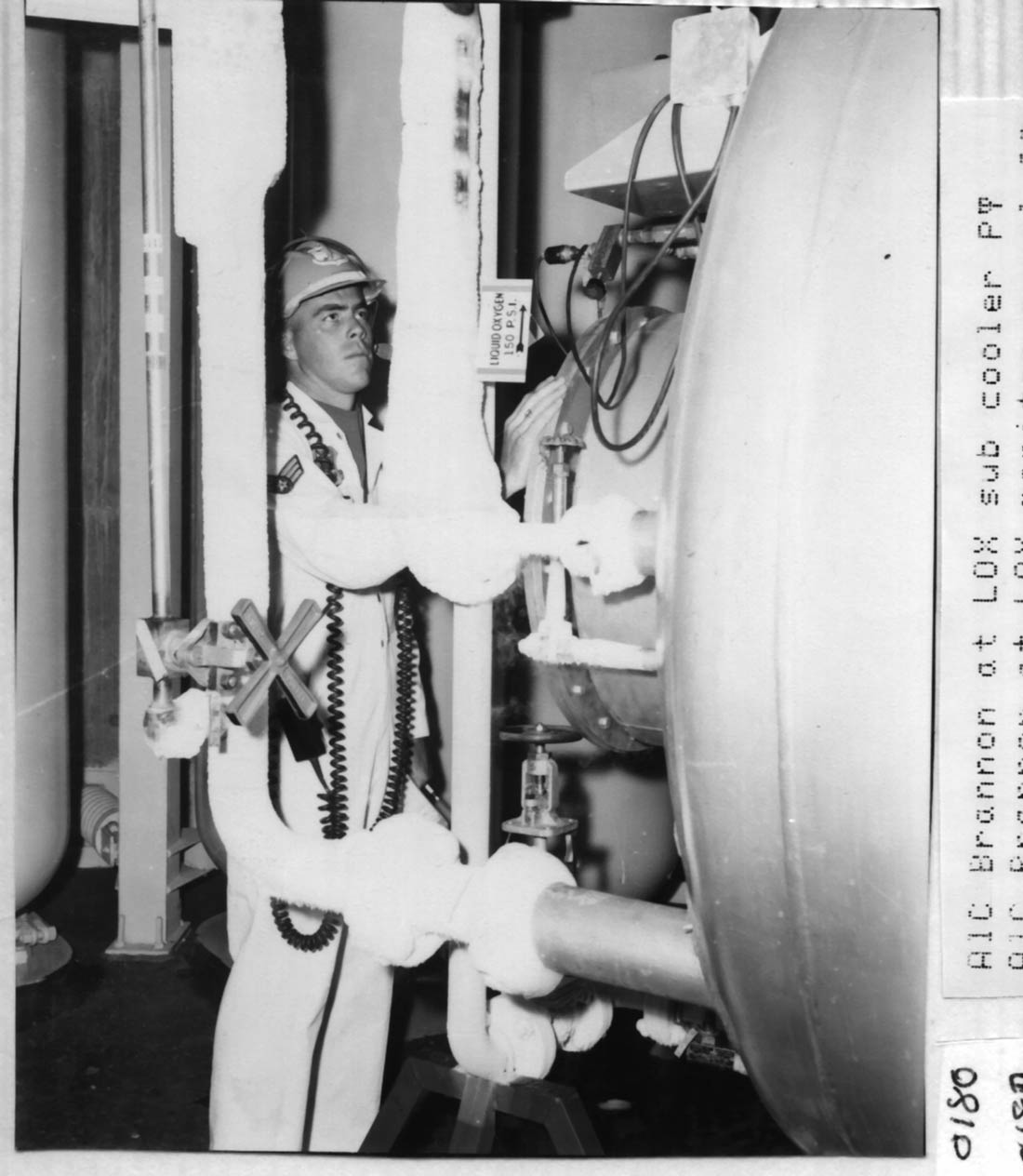
Another
shot of the LOX sub-cooler and A1C Brannon
Photo
courtesy of Fred Epler
|
|
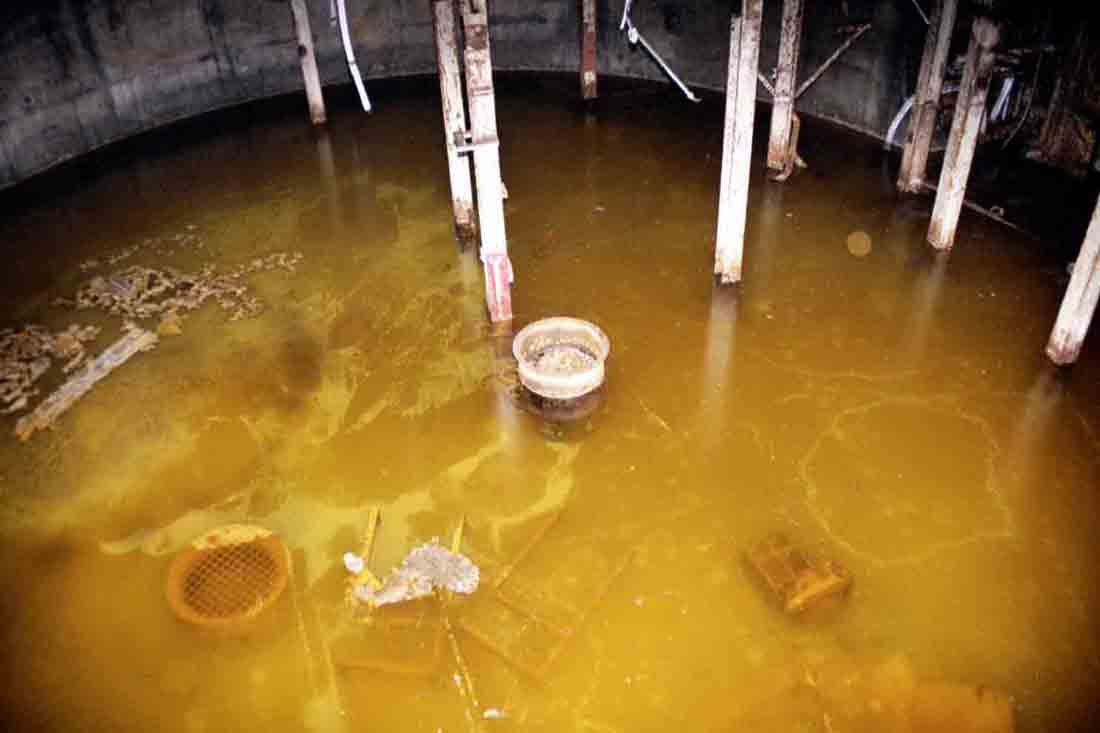
This
is how the lower level of P.T.#1 at 724C looks today-- rusty water and
steel scrap
|
|
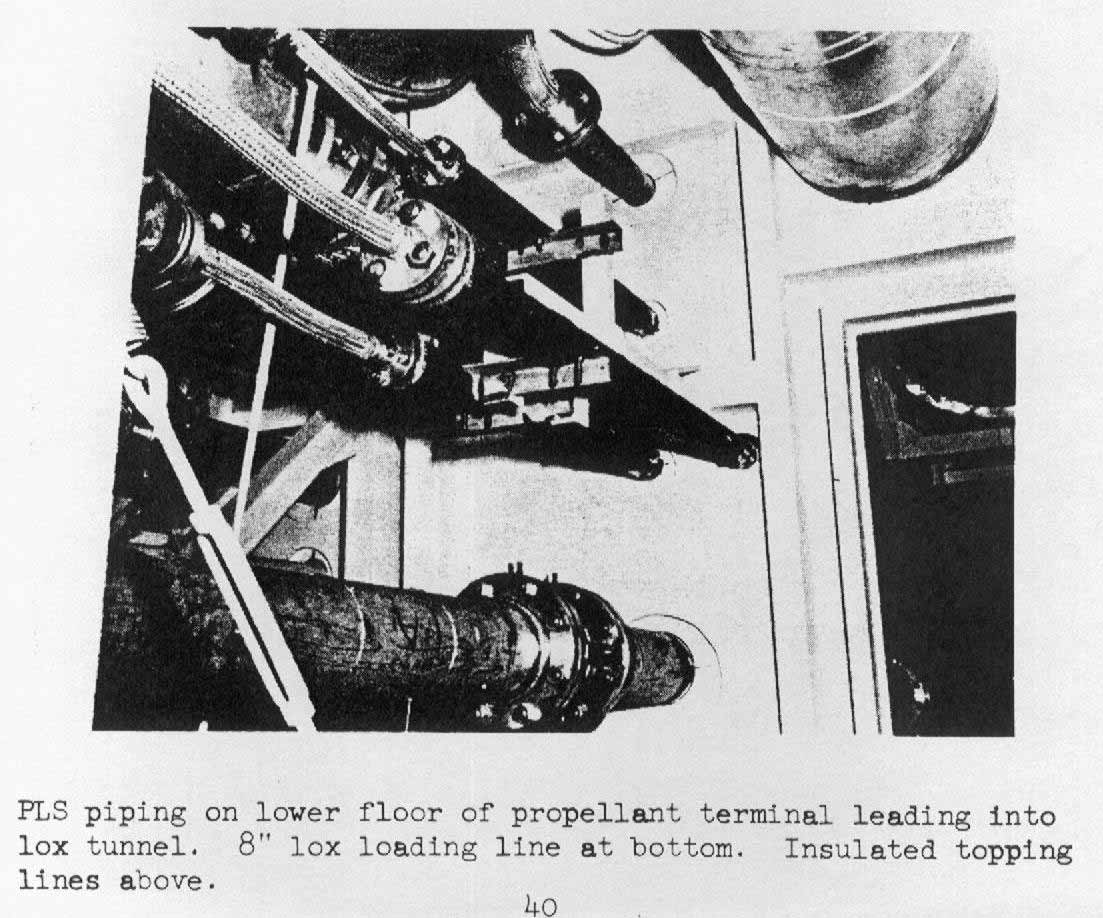
Entrance
to the LOX tunnel during operation
|
|
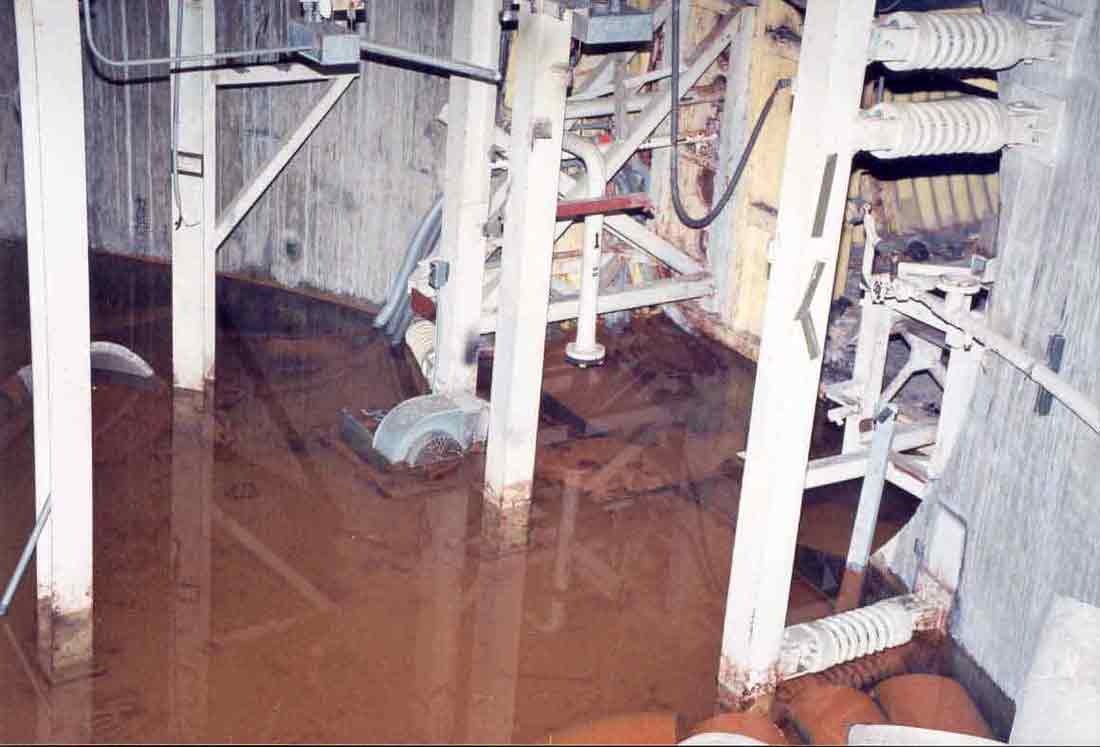
The
entrance to the LOX tunnel today. The wall has been removed along
with the door. You can see a small ventilation blower
half-submerged at center. Ventilation was very important to keep
gasses from accumulating to the point where they could become an
explosion hazard or to the degree that they would displace breathable
air in the terminal. This area maintained a positive pressure to
force air to the surface via the LOX loading and vent shaft that
branched off of the LOX tunnel.
|
From
here you can move on to the LOX Tunnel,
go to the Main Map, or select a destination below:
Current
Location: Propellant Terminals
|
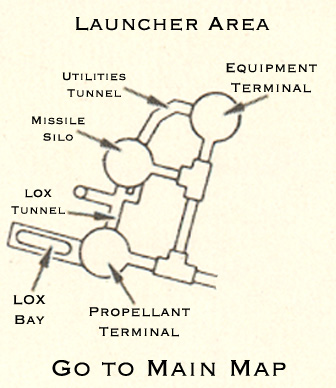
Where
would you like to go next?
|

| Contact
|
Site Map | Links
|
Hosted by
InfoBunker

